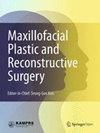在术前计算机断层扫描和三维扫描的引导下,使用处理过的肋软骨进行强化翻修鼻整形术
IF 2.8
Q2 DENTISTRY, ORAL SURGERY & MEDICINE
Maxillofacial Plastic and Reconstructive Surgery
Pub Date : 2024-03-28
DOI:10.1186/s40902-024-00422-z
引用次数: 0
摘要
翻修鼻整形术面临着独特的挑战,尤其是在实现结构完整性和美学和谐方面。本研究探讨了肋骨移植在应对这些挑战方面的功效,重点关注解剖矫正和患者效果。研究对接受肋骨移植修复鼻整形术的患者进行了前瞻性分析。通过术前和术后评估(包括 CT 成像和 3D 扫描)记录,采用算法方法根据个人解剖学需求定制手术技术。共纳入了 34 名患者。术后鼻腔结构和功能均有显著改善。平均 NOSE 分数从术前的 94.47 ± 5.48 分提高到术后的 12.59 ± 13.43 分,平均 ROE 分数从 18.44 ± 10.02 分提高到 92.65 ± 13.00 分,这表明鼻腔气道功能和患者满意度均有大幅提高。使用肋骨移植可有效矫正各种鼻畸形,并发症发生率为 2.94%。翻修鼻整形术中的肋骨移植为复杂的鼻部畸形提供了一种多功能、有效的解决方案。本研究中使用的算法方法提高了可重复性和效果,为在翻修病例中实现理想的美学和功能效果提供了一种可行的途径。为优化技术和评估长期效果,还需要进一步研究。II.本文章由计算机程序翻译,如有差异,请以英文原文为准。
Enhanced revision rhinoplasty with processed costal cartilage guided by preoperative computed tomography and 3D scanning
Revision rhinoplasty presents unique challenges, particularly in achieving structural integrity and aesthetic harmony. This study explores the efficacy of costal grafts in addressing these challenges, focusing on anatomical corrections and patient outcomes. A prospective analysis was conducted on patients undergoing revision rhinoplasty with costal grafts. An algorithmic approach was applied to tailor the surgical technique to individual anatomical needs, documented through pre- and postoperative assessments, including CT imaging and 3D scanning. A total of 34 patients were included. Significant improvements were noted in nasal structure and function post-surgery. The mean NOSE score improved from 94.47 ± 5.48 preoperatively to 12.59 ± 13.43 postoperatively, and the mean ROE score increased from 18.44 ± 10.02 to 92.65 ± 13.00, indicating substantial enhancement in both nasal airway function and patient satisfaction. The use of costal grafts facilitated effective corrections for a broad spectrum of nasal deformities, with a complication rate of 2.94%. Costal grafts in revision rhinoplasty offer a versatile and effective solution for complex nasal deformities. The algorithmic approach used in this study enhances repeatability and outcomes, suggesting a promising avenue for achieving desired aesthetic and functional results in revision cases. Further research is warranted to optimize techniques and evaluate long-term outcomes. II.
求助全文
通过发布文献求助,成功后即可免费获取论文全文。
去求助
来源期刊

Maxillofacial Plastic and Reconstructive Surgery
DENTISTRY, ORAL SURGERY & MEDICINE-
CiteScore
4.30
自引率
13.00%
发文量
37
审稿时长
13 weeks
 求助内容:
求助内容: 应助结果提醒方式:
应助结果提醒方式:


